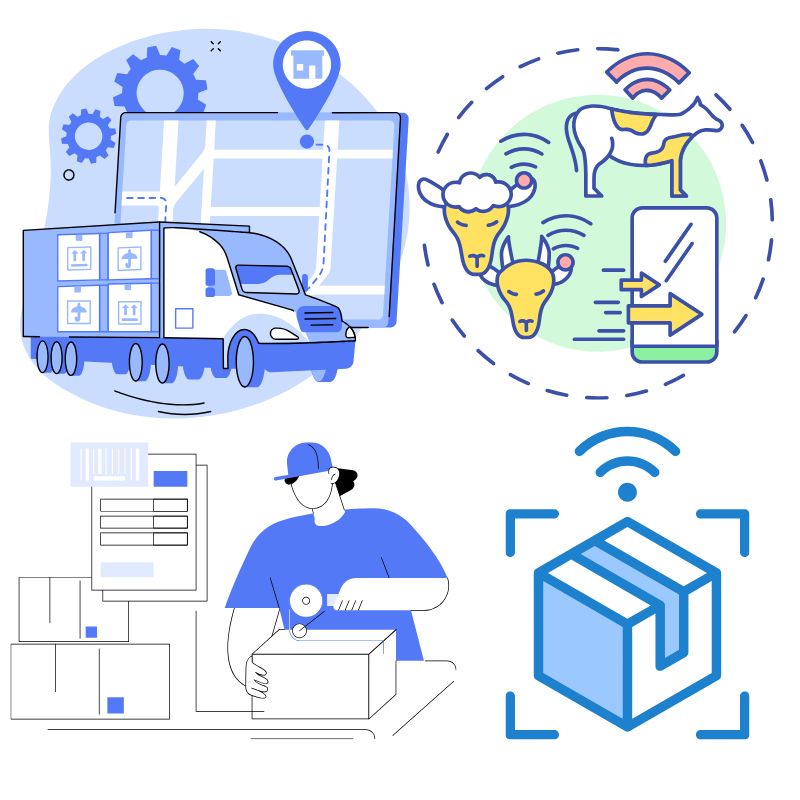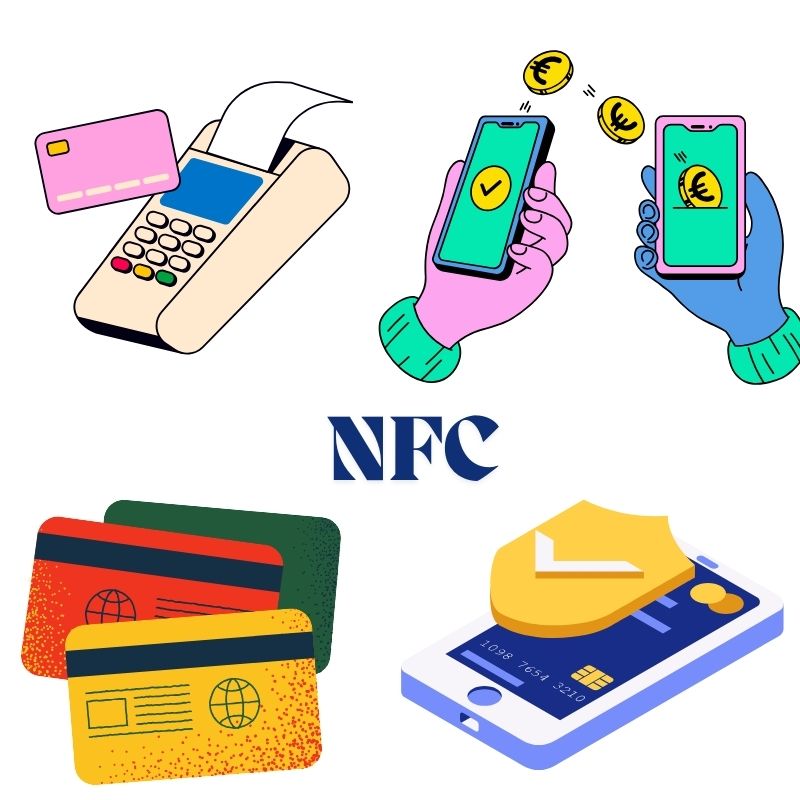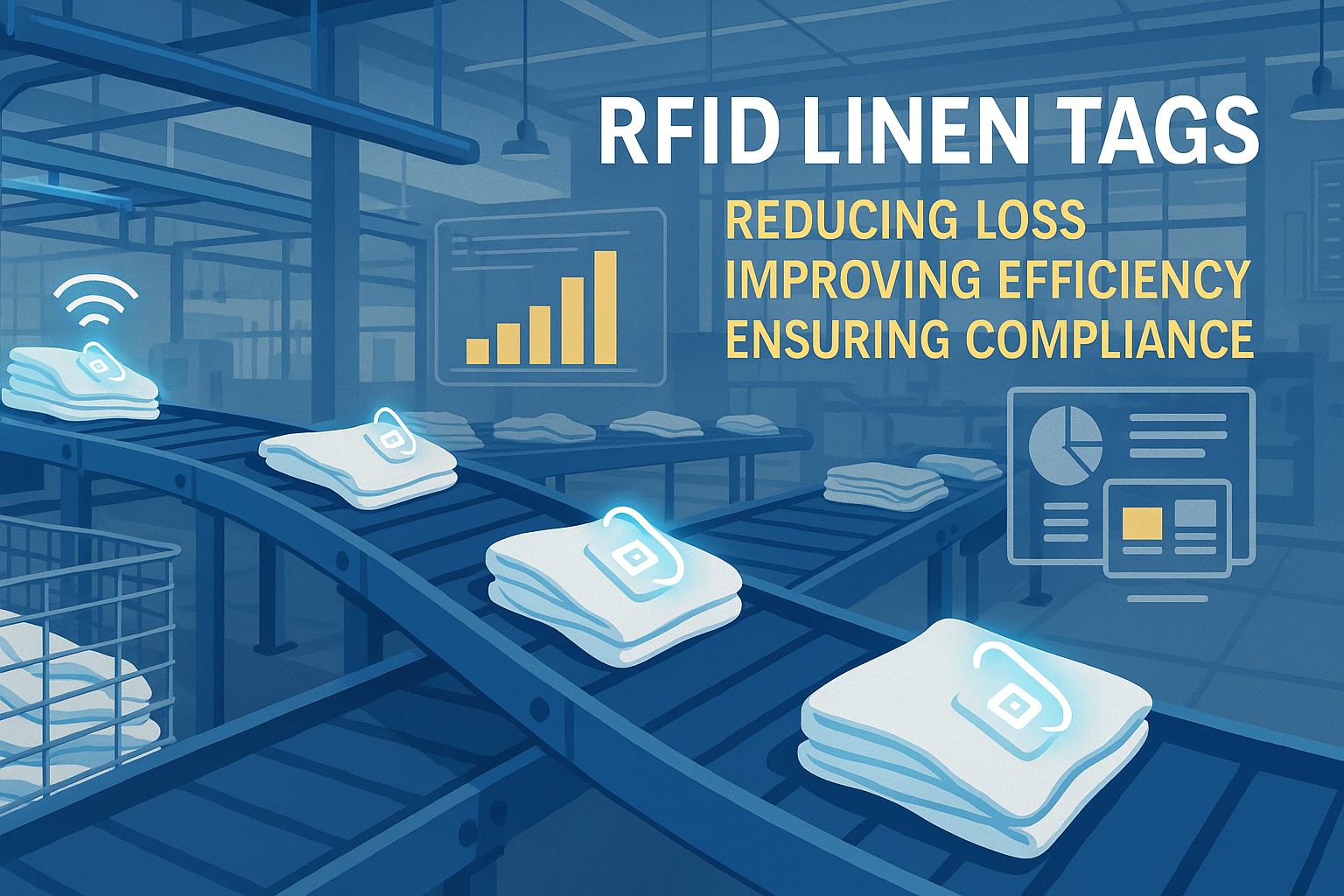
Jaký je rozdíl mezi NFC a RFID?
Obsah
NFC a RFID: Klíčové rozdíly, aplikace a jak si vybrat (průvodce pro rok 2025)
Od sledování zásob až po bezkontaktní platby – tyto bezdrátové komunikační metody pomáhají průmyslovým odvětvím automatizovat procesy, snižovat počet chyb a zvyšovat bezpečnost.
Tento průvodce vysvětluje rozdíly mezi technologiemi RFID a NFC, jejich fungování, použití a to, která z nich nejlépe vyhovuje vašim potřebám v roce 2025.

Co je to RFID a NFC?
RFID (Radio Frequency Identification)
RFID využívá rádiové vlny k automatické identifikaci a sledování objektů pomocí RFID tagů a RFID čteček. Běžně se používá v odvětvích, jako je logistika, maloobchod, výroba a zdravotnictví, ke sledování majetku a zefektivnění operací v dodavatelském řetězci.
- Frekvenční pásma: nízké (LF), vysoké (HF) a ultravysoké (UHF)
- Dosah čtení: až 100 metrů (aktivní tagy)
- Tagy: Pasivní (bez baterie) nebo aktivní (napájené baterií)
- Případy použití: Správa zásob, sledování majetku, kontrola přístupu
NFC (komunikace v blízkém poli)
NFC je specializovaná podskupina RFID, která pracuje na frekvenci 13,56 MHz (HF). Na rozdíl od obecné RFID umožňuje NFC obousměrnou komunikaci mezi zařízeními na velmi krátkou vzdálenost – obvykle méně než 4 cm. Je široce používána pro bezpečnou a rychlou výměnu dat, například pro mobilní platby nebo digitální vizitky.
- Frekvenční pásmo: vysoká frekvence (13,56 MHz)
- Rozsah: V rámci několika centimetrů
- Interaktivita: Podporuje obousměrnou komunikaci
- Příklady použití: Bezkontaktní platby, párování smartphonů, veřejná doprava
NFC vs RFID: Jaký je mezi nimi rozdíl?
Rozdíl mezi RFID a NFC spočívá v dosahu, interaktivitě, výkonu a aplikacích. Zde je stručná srovnávací tabulka:
| Funkce | RFID | NFC |
|---|---|---|
| Frekvenční pásmo | LF, HF, UHF | HF (13,56 MHz) |
| Přečtěte si rozsah | Až 100 metrů | Během několika centimetrů |
| Sdělení | Jednosměrný (většinou) | Obousměrný |
| Zdroj napájení | Pasivní nebo aktivní | Typicky pasivní |
| Aplikace | Skladové zásoby, dodavatelský řetězec, kontrola přístupu | Mobilní platby, sdílení dat |
| Interaktivita | Nízký | Vysoká (interakce uživatel-zařízení) |
- “RFID je ideální pro sledování majetku ve velkém měřítku, zatímco NFC je určeno pro bezpečné interakce na krátkou vzdálenost, jako jsou mobilní platby.”
Jak technologie RFID funguje
Systém RFID se opírá o tři základní komponenty:
- RFID tagy: Ukládají informace o položkách (mohou být pouze pro čtení nebo pro čtení/zápis).
- Čtečka RFID: Vysílá signál pro napájení pasivních tagů a načítání dat.
- Softwarový systém: Interpretuje a spravuje shromážděná data.
Typy RFID štítků
- Pasivní RFID tagy: Bez vnitřní baterie, napájené signálem RFID čtečky.
- Aktivní RFID tagy: Mají vlastní zdroj napájení pro delší dosah a časté aktualizace dat.
Čtečky RFID a NFC jsou k dispozici v ručním i pevném provedení, v závislosti na použití.
Jak funguje NFC
Technologie NFC umožňuje komunikaci na krátkou vzdálenost mezi dvěma zařízeními podporujícími NFC nebo mezi zařízením a NFC tagem.
Výhody NFC:
- Jednoduchost technologie Tap-and-Go: Není nutné párování ani skenování.
- Vysoká bezpečnost: Ideální pro bezkontaktní finanční transakce.
- Obousměrná komunikace: Na rozdíl od většiny RFID systémů mohou data proudit v obou směrech.
Zařízení NFC a RFID Reader jsou stále častěji integrována do smartphonů, POS terminálů a přepravních bran pro rychlou, spolehlivou a bezpečnou interakci.
Aplikace RFID
RFID a NFC pohánějí různé aplikace, ale díky svému dlouhému dosahu a flexibilitě je RFID ideální pro:
Řízení zásob
- Aktualizace v reálném čase
- Automatické sledování napříč sklady
Sledování aktiv
- Monitorujte lékařské vybavení, nástroje nebo vozidla
- Zvyšte efektivitu v logistice a zdravotnictví
Řízení přístupu
- Používejte RFID klíčové karty, přívěsky nebo odznaky
- Kontrola vstupu do zabezpečených budov nebo zón
Aplikace NFC
Bezpečné funkce NFC s krátkým dosahem vynikají v osobních a veřejných aplikacích:
Mobilní platby
- Apple Pay, Google Pay, Samsung Pay.
- Bezpečné transakce během několika sekund.
Chytrá zařízení a marketing
- Klepnutím spustíte aplikace nebo sdílíte kontaktní údaje.
- Chytré štítky pro informace o produktech nebo přihlášení.
Dopravní systémy
- Bezkontaktní dopravní karty.
- Snadné nastupování v sítích metra a autobusů.

NFC vs RFID: Kterou technologii byste měli používat?
| Use Case | Nejlepší technologie |
|---|---|
| Sledování na dlouhé vzdálenosti | RFID |
| Skladové zásoby nebo dodavatelský řetězec | RFID |
| Bezpečné osobní transakce | NFC |
| Mobilní platby a identifikace | NFC |
| Inteligentní automatizace IoT | Obě |
Pokud spravujete tisíce aktiv, RFID je pro vás tou správnou volbou. Pro individuální, bezpečné interakce, jako je přiložení telefonu, je jasnou volbou NFC.
NFC a RFID v IoT (internet věcí)
RFID a NFC jsou základními prvky ekosystémů IoT, které umožňují fyzickým objektům “komunikovat” s digitálními systémy.
- RFID v IoT: Monitoruje zboží v dodavatelských řetězcích a výrobních provozech.
- NFC v IoT: Umožňuje bezpečné párování zařízení, přístup k inteligentní domácnosti a ovládání v reálném čase prostřednictvím smartphonů.
“Kombinace tagů NFC a RFID mění IoT tím, že propojuje fyzická aktiva s cloudem.”
Úloha frekvence ve výkonu NFC a RFID
Porozumění frekvenci pomáhá při výběru správného systému:
- LF (125–134 kHz) – Krátký dosah, používá se v oblasti kontroly přístupu
- HF (13,56 MHz) – Používá se jak pro RFID, tak pro NFC
- UHF (860-960 MHz) – Dlouhý dosah, ideální pro dodavatelské řetězce
Každá frekvence podporuje různé rozsahy a rychlosti čtení, proto je výběr čtečky RFID a NFC důležitý pro výkon systému.
Často kladené otázky o NFC a RFID
Jaký je hlavní rozdíl mezi RFID a NFC?
NFC je podskupinou RFID. Zatímco RFID podporuje delší dosah a jednosměrnou komunikaci, NFC je navrženo pro obousměrnou komunikaci na krátkou vzdálenost.
Lze NFC a RFID tagy používat zaměnitelně?
Ne vždy. NFC funguje pouze na vysokofrekvenčním pásmu, zatímco RFID může využívat nízkofrekvenční, vysokofrekvenční nebo ultra vysokofrekvenční pásmo. NFC tagy fungují pouze s NFC čtečkami, nikoli se všemi RFID čtečkami.
Jsou štítky RFID bezpečné?
Pasivní RFID tagy mohou být bez šifrování zranitelné. NFC nabízí vyšší úroveň vestavěného zabezpečení, zejména pro finanční transakce.
Co je to čtečka NFC a RFID?
Jedná se o zařízení sloužící ke čtení RFID nebo NFC tagů. Mnoho moderních smartphonů funguje jako NFC čtečky pro bezkontaktní akce.
Jak fungují platby pomocí technologie NFC?
Zařízení využívají technologii NFC k bezdrátovému přenosu šifrovaných platebních údajů do kompatibilních terminálů – bez nutnosti fyzického kontaktu.
Která odvětví těží z RFID nejvíce?
Maloobchod, zdravotnictví, logistika, výroba a skladování využívají RFID pro automatizaci a přehlednost.
Závěrečné myšlenky
Jak RFID, tak NFC nabízejí významnou hodnotu – ať už sledujete palety nebo provádíte platby pomocí smartphonu. Vaše volba by měla odpovídat vašim provozním potřebám:
- Pro široké automatické sledování zvolte RFID.
- Pro bezpečné interakce na krátkou vzdálenost použijte technologii NFC.
Vzhledem k tomu, že se RFID a NFC tagy vyvíjejí spolu s IoT, je nyní ideální čas je integrovat do vašeho pracovního postupu.
Potřebujete pomoc s výběrem správného systému NFC nebo RFID pro vaši firmu?
Kontaktujte nás dnes nebo si prohlédněte naši kompletní nabídku čteček a tagů NFC a RFID.

Ray Zhou
Tento článek napsal Ray Zhou, odborník na technologii RFID s více než desetiletou praxí v oboru.
Komentáře
Horké produkty

Co je to RFID odpadové hospodářství
Představte si město, kde každá popelnice komunikuje – ne doslova, ale prostřednictvím malého čipu, který systému sděluje, kdy je plná, kdy byla vyprázdněna a kam byla odvezena. To je to, co dnes dělá systém RFID pro nakládání s odpady.

Co jsou šroubová těsnění a jejich použití? | Kompletní průvodce
V celosvětovém obchodě a logistice hrají šroubové plomby klíčovou roli při zajišťování bezpečnosti nákladu a dodržování předpisů. Tato malá, ale výkonná zařízení jsou určena k uzamykání přepravních kontejnerů, přívěsů a nákladních dveří pomocí mechanismu, který je odolný proti manipulaci.

Co je to chránič karet RFID? Výhody, případy použití a průvodce nákupem
Technologie RFID (Radio Frequency Identification) je všude: na kreditních kartách, identifikačních průkazech, jízdenkách, klíčích od hotelových pokojů a dalších zařízeních. Nabízí rychlost a pohodlí, ale také otevírá dveře novému druhu digitálních krádeží, kterému se říká "skimming". Proto se hodí chránič karet RFID.

Náramky RFID pro akce: Průvodce hromadným nákupem pro organizátory
Náramky RFID pro akce se stávají řešením pro organizátory, kteří potřebují rychlejší vstup, prevenci podvodů a bezhotovostní platby na koncertech, festivalech a sportovištích. Na rozdíl od papírových vstupenek nebo QR kódů používají tyto chytré náramky zabudované čipy, které zjednodušují přístup, zabezpečují transakce a zlepšují zážitek návštěvníků.

Jak štítek RFID na čelním skle zlepšuje systémy kontroly přístupu do vozidel a mýtné systémy
V dnešním rychlém světě musí být identifikace vozidla rychlá, bezpečná a bezkontaktní. Tag RFID na čelním skle je přesně takový - představuje spolehlivý způsob správy výběru mýtného, parkování a vjezdu do závor bez zastavování vozidel.

Výhody štítků RFID pro praní prádla v komerčních prádelnách
Řízení prádelny v nemocnicích, hotelech nebo velkých prádelnách je náročná práce. Každý den se vyperou, roztřídí a odešlou zpět tisíce prostěradel, ručníků a uniforem. Problémy, jako jsou ztráty prádla, chyby při třídění a ruční počítání, však mohou společnosti stát spoustu peněz. Například středně velké hotely mohou každý rok přijít o více než $200 000 kvůli chybějícímu prádlu.
Proto přicházejí na řadu štítky RFID na prádlo.
Tagy
SOUVISEJÍCÍ BLOGY

Co je to RFID odpadové hospodářství
Představte si město, kde každá popelnice komunikuje – ne doslova, ale prostřednictvím malého čipu, který systému sděluje, kdy je plná, kdy byla vyprázdněna a kam byla odvezena. To je to, co dnes dělá systém RFID pro nakládání s odpady.

Co jsou šroubová těsnění a jejich použití? | Kompletní průvodce
V celosvětovém obchodě a logistice hrají šroubové plomby klíčovou roli při zajišťování bezpečnosti nákladu a dodržování předpisů. Tato malá, ale výkonná zařízení jsou určena k uzamykání přepravních kontejnerů, přívěsů a nákladních dveří pomocí mechanismu, který je odolný proti manipulaci.

Co je to chránič karet RFID? Výhody, případy použití a průvodce nákupem
Technologie RFID (Radio Frequency Identification) je všude: na kreditních kartách, identifikačních průkazech, jízdenkách, klíčích od hotelových pokojů a dalších zařízeních. Nabízí rychlost a pohodlí, ale také otevírá dveře novému druhu digitálních krádeží, kterému se říká "skimming". Proto se hodí chránič karet RFID.




